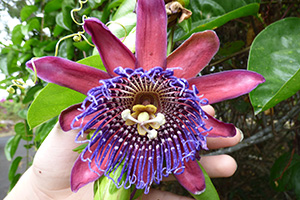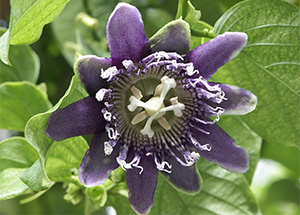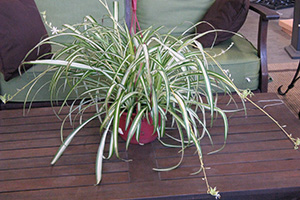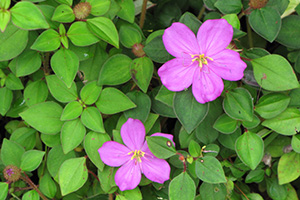Invasives Update

Updates from the UF/IFAS Assessment
The UF/IFAS Assessment of Non-Native Plants in Florida’s Natural Areas uses research-based tools to evaluate the invasion risk of species that did not evolve in Florida. These plants below are now listed as high risk of invasion, meaning they are not yet considered established outside of cultivation in Florida, but are predicted to become invasive if introduced to the state. As a result, they’re not recommended for Florida gardening for risk of spreading and impacting native plants and local ecosystems.
Giant Granadilla (Passiflora quadrangularis)

Giant granadilla (Passiflora quadrangularis)—also known as barbadine, grenadine, giant tumbo, or badea—originated in South America. This woody or herbaceous vine is cultivated for its fragrant, attractive flowers and edible fruits. It has heart-shaped seeds and greenish-yellow oblong berries up to 8 inches in length. Giant granadilla prefers to grow in hot, humid areas in tropical and subtropical climates. It is a vigorous climber that grows over small trees and shrubs, blocking understory plants from access to sunlight. This can prevent the growth of native plants. It has been listed as one of the most aggressive invasive plants in the Galapagos.
Spider Plant (Chlorophytum comosum)

Spider plant (Chlorophytum comosum) is also known as spider-ivy, airplane plant, ribbon plant, common spider plant, or hen and chickens. Originating in Africa, it’s commonly found in hanging baskets throughout Florida homes, with mounds of white- or yellow-striped narrow leaves. Spider plant gets its name from the tiny “spidery” plantlets that form at the tips of long arching shoots. It matures quickly and is easily propagated vegetatively. Subsequently, its fragments readily grow into individual plants and are susceptible to being spread accidentally by humans through contaminated soils and garden waste. Due to these properties, it has become a serious weed in Australia.
Dieffenbachia (Dieffenbachia seguine)

Dieffenbachia (Dieffenbachia seguine) originated in South America, Central America, and North America-Mexico. It is an attractive indoor tropical plant with thick, large leaves that have a mixed coloration of green, white, and yellow. This herbaceous plant grows up to 5 feet tall with leaves and stems that contain a white sap. When consumed, the sap can cause swelling of the mouth that prevents speaking and swallowing. Dieffenbachia has been documented to crowd out other species in moist, forested areas and stream banks. It negatively impacts agriculture, forestry, and native biodiversity, and has especially been problematic in the Pacific islands.
Pink Lady (Dissotis rotundifolia)

Pink lady (Dissotis rotundifolia or Heterotis rotundifolia), also known as Spanish shawl and rockrose, originated in Africa. This fast-growing herb is commonly used as an ornamental and groundcover plant. The leaves, stems, and fruits are hairy and the flowers bloom in magenta-pink or purple hues. Pink lady is a creeping plant that can form dense mats that outcompete native plants in both open and forested areas. This perennial climber can spread via plant fragments, seeds, and root suckers and has been especially problematic in the Pacific islands.
Other plants were recently assessed to have a low invasion risk, including walking iris (Neomarica gracilis), pompon tree (Dais cotinifolia), and Kimberley Queen fern (Nephrolepis obliterata). Banyan tree (Ficus benghalensis) was assessed as “not a problem species (documented).” For more information about other non-native plants, visit UF/IFAS Assessment of Non-Native Plants in Florida’s Natural Areas.
Also on Gardening Solutions
- Heartleaf Philodendron (houseplant)
- Invasives Update Fall 2024
- Native Passion Flower
- Powderpuff Mimosa (pink-flowering groundcover)
- Walking Iris
